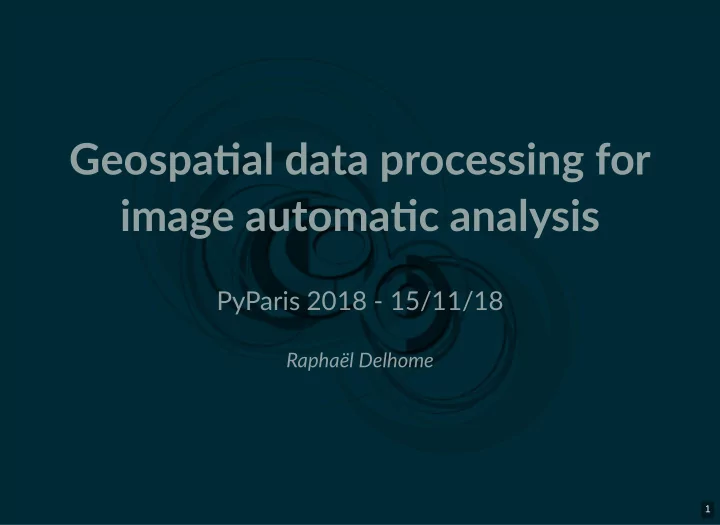

Geospa�al data processing for image automa�c analysis PyParis 2018 - 15/11/18 Raphaël Delhome 1
Introduction Introduction 2
Oslandia... Oslandia... since 2009 Open Source specialist GIS experts (QGIS contributors) Provide geospa�al data solu�ons today: 17 teammates 3
...and I ...and I At Oslandia for 1.5 year Data Scien�st in charge of R&D ac�ons 4
Context Context Ar�ficial Intelligence at Oslandia Aerial image democra�za�on A historic use case: building footprint detec�on 5
Deep learning and geospatial Deep learning and geospatial data data 6
Image analysis use cases at Image analysis use cases at Oslandia Oslandia Tech stack: Linux, Python (Keras, Pillow, ...) Seman�c segmenta�on Instance segmenta�on Street-scene images Aerial images Aerial images OpenStreetMap data parsing (github.com/Oslandia/deeposlandia) 7
Semantic segmentation Semantic segmentation Inputs N images ( P x P pixels, C channels), L labels Outputs N arrays of shape P x P x L 8
Mapillary dataset Mapillary dataset .jpg images and .png labels (from 800x600 pixels to 5500x4000 pixels) 25000 images (18000 for training, 2000 for valida�on) 9
AerialImage (INRIA) AerialImage (INRIA) Georeferenced .�ff images (5000 * 5000 pixels) 360 images (10 ci�es of 36 �les each) 50% training, 50% tes�ng 10
Link with OSM data Link with OSM data Rebuild labelled images star�ng from OSM database OSM data as Ground-truth OR addi�onal input data Process: Extract coordinates (GDAL) Query OSM data (Overpass) Store the data in the database (osm2pgsql) Generate raster �le (Mapnik) (github.com/Oslandia/osm-deep-labels) 11
Link with OSM data Link with OSM data Le� : raw image Center : ground-truth label Right : OSM raster 12
Instance segmentation Instance segmentation Inputs N images ( P x P pixels, C channels), L labels Outputs N arrays of shape P x P x S , with S the instance number ( cf Mask-RCNN ) 13
Main issue Main issue Design a geospa�al data pipeline for IA treatments : Luigi package (1 opera�on = 1 pipeline task) Tanzania challenge as an opportunity to implement it 14
Pipeline design Pipeline design 15
Tanzania challenge Tanzania challenge organized by Challenge WeRobo�cs Building instance detec�on and status discrimina�on (completed, unfinished, founda�on) in Tanzania 13 images (from 17k x 42k to 51k x 51k pixels) 16
Data parsing Data parsing 17
Data preprocessing Data preprocessing Generate �les: GDAL (integrated in the Python pipeline through sh ) gdal_translate -srcwin <min-x> <min-y> <tile-width> <tile-heigh <input-path> <output-path> Get geo-features: GDAL from osgeo import gdal ds = gdal.Open(filename) # ds.RasterXSize, ds.RasterYSize, # ds.GetGeoTransform(), ds.GetProjection() 18
Data preprocessing Data preprocessing Store labels to database: ogr2ogr (integrated in the Python pipeline through sh ) ogr2ogr -f PostGreSQL <conn-string> <input-path> -t_srs EPSG:<srid> -nln <table-name> -overwrite Extract �le items: PostGIS (and psycopg2 ) WITH bbox AS SELECT(ST_MakeEnvelope(<bbox_coordinates>)) SELECT <building_intersection> FROM <table> AS t JOIN bbox ON ST_Intersects(t.geom, bbox.geom) 19
Data preprocessing Data preprocessing 20
Model training Model training github.com/ma�erport/Mask_RCNN Instance-specific segmenta�on on various object types (complete buildings, incomplete buildings, founda�ons) Hyperparameter se�ngs: number of training epochs? Learning rate? Hardware cri�city: 1 GTX 1070Ti GPU 21
Model training Model training 22
Model inference Model inference Generate �les on test images ( cf training image processing) Predic�on through Mask_RCNN package from mrcnn import model as modellib model = modellib.MaskRCNN(mode="inference", config=<config>, model_dir=<model_path>) weights_path = model.find_last() model.load_weights(weights_path, by_name=True) result = model.detect(<image_data>) Output: N boolean masks, N class_ids, N scores ( N being the number of detected instances) 23
Model inference Model inference 24
Postprocessing Postprocessing Post-process detec�on output Detect polygon contours within boolean masks: OpenCV Transform pixels into geographical coordinates Build polygons with geojson and shapely geom = geojson.Polygon(<list-of-points>) polygon = shapely.geometry.shape(geom) Output: .csv files with building IDs, predic�on scores, geometries 25
Postprocessing Postprocessing Merge results: pandas pred = pd.concat([pd.read_csv(filename) for filename in <postprocess_folder>]) Geo-localize results : shapely , GeoPandas pred["geom"] = [shapely.wkt.loads(s) for s in pred["coords_geo"]] gdf = gpd.GeoDataFrame(pred, geometry="geom") gdf.to_file(<outputpath>, driver="GeoJSON") 26
Postprocessing Postprocessing 27
Put it all together Put it all together 28
Result visualization Result visualization 29
Conclusion Conclusion 30
Output and discussion Output and discussion Geospa�al data pipeline Proof of Concept ...However very poor results for now :-( Areas for improvement: consider the images without any instance manage iden�cal building on adjacent �les on manner Robosat ... S�ll on processing! :-) 31
Bonus track: web app demo Bonus track: web app demo 32
Thank you for your Thank you for your attention! attention! Find out more: (Tanzania challenge code open sourced soon) h�ps:/ /oslandia.com/en/blog/ github.com/Oslandia/deeposlandia github.com/Oslandia/osm-deep-labels h�p:/ /data.oslandia.io 33
Recommend
More recommend